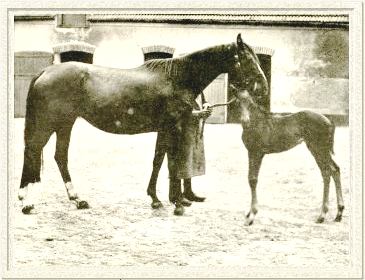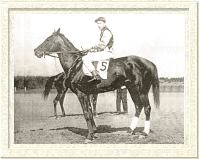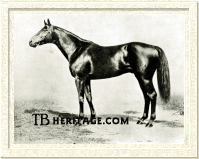|
|
Curiosity

|
|
 |
|
|
Curiosity, who vanished in the carnage of World War I when an aged mare, was an American-bred filly whose name is woven into the fabric of U.S. and South American pedigrees through her only two American foals, Novelty and Wonder.
Curiosity was bred by James R. Keene and foaled in 1903 at Keene's famed Castleton Stud near Lexington, Kentucky. Her sire was imported Voter and her dam was a daughter of Domino named Pink Domino.
Voter was bred in England by Keene's son Foxhall. He was by Friar's Balsam, a good son of Hermit, out of Mavourneen, by the great stayer Barcaldine. Voter was sent to the United States as a foal alongside his dam. Mavourneen was in foal to Amphion, and the foal she was carrying, born at Castleton, was a filly named Maid of Erin, who went on to become the dam of stakes winner Celt. Mavourneen's son Voter enjoyed a long and successful racing career, becoming a high class sprinter for the Castelton stables. Racing through the age of seven, Voter garnered 26 victories, including triumphs in such prestigious events as the Metropolitan Handicap (defeating among others Belmont Stakes champion Hastings), the Fall Handicap at Coney Island (defeating a field which included the top class colt Ornament), and the Toboggan Handicap. At stud at Castleton, Voter got two important sons in Ballot and Runnymede, the latter sire of dual American classic winner Morvich. Curiosity was a member of Voter's first crop.
In the early 1890s, James Keene bought over forty English mares and shipped them to Castleton. During the next two decades, mating these imported mares with his top stallions Domino, Ben Brush, and Commando, an impressive array of stakes winners was produced. In addition to Mavourneen, from England Keene also acquired Belle Rose, for 290 guineas, and her stakes-winning daughter Royal Rose. Belle Rose and her daughter were members of the Woodbine branch of the champion mare Beeswing. Keene looked not so much for racing quality as good pedigree, as evidenced by the fact that only a small fraction of the mares he imported showed any ability on the racecourse.
Belle Rose became a foundation mare for Castleton Stud, for her daughters, Royal Rose and Pink Domino, the latter born at Castleton from a union with Domino, became major producers for Keene. Royal Rose produced four stakes winners, including Pennant, as well as that horse's full sister, important producer Cherokee Rose, while Pink Domino, a winner, was destined to become the dam of Curiosity and her more famous half-brother Sweep, classic winner of the Belmont Stakes, as well as a leading sire and sire of broodmares.
Curiosity went to the track as a juvenile. In the Great Filly Stakes at Sheepshead Bay in New York, run over the Futurity course, she raced in fifth and sixth position before quitting badly in the stretch, going wide on the turn, and finishing next to last. In the 3/4 mile Spinaway Stakes for two-year-old fillies at Saratoga she ran third.
She was sent home to Castleton, where she produced two foals destined to make their mark on the breed. The first was NOVELTY, a colt by leading sire Kingston, foaled in 1908. Keene elected not to keep Novelty, sending him and 25 other Castleton-bred yearlings to the Sheepshead Bay sale in July of 1909. The son of Kingston and Curiosity was knocked down to prominent horseman John E. Madden for $1700. Novelty was sent to trainer Chuck Walker and made his debut at Belmont Park in May, 1910, winning that allowance with consummate ease. Soon after, Madden sold Novelty to trainer Sam Hildreth for $10,000.
|

Novelty, a winner on 3 continents
| |
For Hildreth, Novelty developed into the best two-year-colt of his generation, running fifteen times during the course of the season and winning nine of these, including his last five in a row. Among his victories were the Saratoga Special, in which near-relative Iron Mask (by Disguise out of Royal Rose) finished second; the Hopeful Stakes, defeating Iron Mask and another close relative, the filly Sweepaway, (a daughter of Ben Brush and Pink Domino); and the Futurity, in which he again defeated Iron Mask, as well as Bashti and the good filly Love-Not. |
The Futurity of 1910 was the last day of racing in New York, anti-betting legislation rendering New York tracks dark for the next two and half years. Belmont Park did not re-open until May of 1913. Hildreth kept Novelty in training, running him in Maryland and Canada and winning races with him, before transferring his training operations to France. There, in 1912 and 1913, Novelty won races, both on the flat and over hurdles. In August of 1913, Novelty was offered for sale at Deauville and was purchased by Brazilian breeder Linneo de Paulo Machado, the price tag being 35,000 francs, or approximately $10,000. Novelty ran for his new owner a couple times in France before being shipped to Brazil, where he also raced and won. Thus Novelty gained the distinction of winning in four countries -America, Canada, France, and Brazil--on three continents--North America, Europe, and South America--quite an accomplishment in the days before air travel existed.
Machado installed Novelty at his San Jose Stud near Sao Paolo. As a stallion in Brazil, Novelty excelled, both as a sire of runners and a sire of broodmares. Novelty was champion sire in Brazil in 1921, 1922, 1923, and 1924, second on the list in 1925, 1927, 1928, and 1930, and third in 1926 and 1929. Of his sons, the best was probably Santarem, a winner of many stakes in Brazil and later an influential stallion, whose major representatives included Holkar and Funny Boy, winner of the Grande Premio Cruzeiro do Sul (Brazilian Derby), as well as top sprinter Buscape and Ever Ready, a winner of the Brazilian Derby. Kitchner was another good sire son of Novelty, his best representative being Mossoro, winner of the very first running, in 1933, of the Grande Premio Brasil, as well winner of the Brazilian Derby, Grande Premio Distrito Federal (Brazilian St. Leger), and the Grande Premio Dezesseis de Julho.
Daughters of Novelty were prized producers. Daughter Miragaia, foaled in 1918, was a stakes winner and as a broodmare had the distinction of having every one of her foals be a winner. Mirgaia's offspring included Miragaio, winner of the Brazilian Two Thousand Guineas, and Sem Medo, stakes winner and dam of top runners Zermatt, Crecelle, and Dona Sol. Miragaia's daughter Tocaia, was a winner, and became the dam of several high class runners, including the tough mare Tacy, winner of several important Brazilian stakes, including the Brazilian Two Thousand Guineas; stakes winner Toca; and Brazilian Triple Crown champion Criolan. Novelty's daughter Liette produced stakes winner Lucky Strike, while another daughter, Lapa, became the granddam of three high class runners in Nuricy, Lido, and Negus. Novelty died in February 1938, aged 30.
The second important foal produced by Curiosity was born in 1910, a chestnut filly by Disguise named WONDER. This filly was closely inbred to Domino, her sire Disguise being a son of Domino and her second dam, Pink Domino, being a Domino daughter. This made Wonder inbred 2x3 to Keene's great champion. Wonder made no recorded starts. She was sold to Harry Payne Whitney. Wonder became a prominent producer for Whitney, her offspring including two full siblings by Whisk Broom II, namely John P. Grier and Miss Whisk.
|

Curiosity's grandson, John P. Grier
| |
John P. Grier, foaled in 1917, had the misfortune to be foaled in the same year as Man o' War, that son of Fair Play becoming the most dominant racehorse of the years 1919 and 1920. John P. Grier ran second to Man O' War in the Futurity as a juvenile and third to him in the Travers Stakes. The little colt's finest hour came in the Dwyer Handicap, where he was Man o' War's sole opponent. John P. Grier challenged his more heralded adversary virtually throughout the 1-1/8 mile contest, before giving way near the finish. Without the specter of Samuel Riddle's golden colt, John P. Grier did win the Aqueduct, Edgemere, and Annapolis Handicaps at three and the Queen's County Handicap at four, in 1921. |
At stud, John P. Grier sired champion juvenile colt El Chico; Metropolitan Handicap winner Jack High; stakes-winning filly Straightlace; and Hopeful Stakes winner Boojum. As a broodmare sire, John P. Grier fathered the dam of Belmont Stakes winner Bounding Home, but his most significant daughter was Miyako, a minor stakes winner but famed as the second dam of dual classic winner and influential sire Native Dancer.
Miss Whisk, four years younger than John P. Grier, was a stakes-placed performer and winner of six of her twenty-six starts. As a broodmare, she produced two stakes winners. It is through Miss Whisk and her daughters that the female line of Curiosity comes down to the present day.
Dustmall was a daughter of Miss Whisk by Chicle, and was foaled in 1927. She was a victress in Belmont's Matron Stakes and became the dam of Red Rain, winner of the Flash Stakes, Hopeful Stakes, and Saratoga Special at two and some steeplechase handicaps as an older performer. A daughter of Dustmall, sired by imported Mahmoud, and named Dusty Legs, was stakes-placed, but became noteworthy as the third dam of Venezuelan classic winner Torrejon and two-time American Horse of the Year John Henry.
Probably the most important offspring of Miss Whisk was the Dis Donc filly Fly Swatter, foaled in 1935. Fly Swatter proved useless on the racecourse, failing to notch even a place in three lifetime starts. As a broodmare for Harry Payne Whitney's son, Cornelius Vanderbilt Whitney, Fly Swatter produced two stakes winners, the Firethorn filly Flyweight and the Mahmoud filly First Flight. The latter was named champion two-year filly in 1946 when she racked up victories in the Fashion, Astoria, and Matron Stakes and the Belmont Futurity over colts. Later in her career, First Flight captured the Monmouth Oaks and the Fall Highweight Handicap. Sadly, First Flight did not make an impact as a producer. First Flight's full sister, Swanky, became the dam of C.V. Whitney's champion turf performer Career Boy. Sired by Phalanx, Career Boy was named champion grass male in 1956. His biggest win came in the prestigious United Nations Handicap, also running second to Needles in the Belmont Stakes and a game fourth when shipped overseas for the Prix de L'Arc de Triomphe.
Flyweight, victress in the Betsy Ross Handicap, produced to the cover of Count Fleet, the winning filly Flynet. Through Flynet have come such descendants as Maryland Oaks winner Beware of the Cat, dam of Belmont Stakes champion Editor's Note and French Group I winner Hold That Tiger; Island Kitty, dam of stakes winners Shy Tom, Hennessy, and Pearl City; and champion two-year-old filly Family Style and her Grade I-winning half-sister Lost Kitty.
In 1912, after producing a dead foal at Castleton the previous season, Curiosity was sold. Like her son Novelty, she became the property of Samuel Hildreth, and was sent to the farm in France he had purchased with his wife when transferring his training operations overseas following the New York racing blackout. In his memoir The Spell of the Turf, written with James R. Crowell, Hildreth wrote of Curiosity that "she was still sending a line of sons and daughters to the races endowed with her own instincts of what Thoroughbreds are expected to do. And when the World War came along the usefulness of her existence continued, for she was mustered into service in the French Army, and word came back from the military zones that she was being ridden by a French army officer."
The fate of Curiosity after she was last seen carrying her rider in the French war zone will forever remain a mystery. It will never be known if she was killed during the hostilities or managed to survive and live to a ripe old age in peaceful anonymity. Her blood, though, was passed on, to descendants whose exploits on the racetrack and in the breeding shed made sure her genes did not disappear, like she herself did, into the mists of time.
--Liz Martiniak
|
|
|
|

